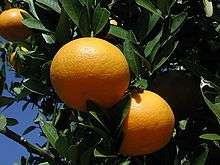Iyokan
| Iyokan | |
|---|---|
 | |
| Iyokan | |
| Scientific classification | |
| Kingdom: | Plantae |
| (unranked): | Angiosperms |
| (unranked): | Eudicots |
| (unranked): | Rosids |
| Order: | Sapindales |
| Family: | Rutaceae |
| Genus: | Citrus |
| Species: | C. × iyo |
The iyokan (伊予柑 - C. × iyo), also known as anadomikan (穴門みかん) and Gokaku no Iyokan,[1] is a Japanese citrus fruit, similar in appearance to a mandarin orange. It is the second most widely produced citrus fruit in Japan after the satsuma mandarin.
Iyokan was discovered in Yamaguchi Prefecture during the Meiji era. Nowadays it mostly grows in Ehime Prefecture. Iyokan are named after Ehime Prefecture which was once called "Iyo-koku" (Iyo-country).[2]
Description
The peel is thicker than a mikan, but it can be peeled by hand. The skin is very shiny and brightly colored and, once peeled, the flesh gives off a very strong scent.[2] The flesh is slightly sour and more bitter than an orange, but sweeter than a grapefruit.
There is a variation grown into a pentagon shape to promote good luck and to revive the popularity of the fruit, also giving it another nickname, Gokaku no Iyokan, which translates into 'sweet smell of success in exams.'[3][4] It is sometimes placed into fish feed to mask the fishy flavor.[5]
See also
References
- ↑ "Japanese farmers create pentagon-shaped oranges". whatsonxiamen.com.
- 1 2 "Ehime Citrus fruits > Varieties of Ehime Citrus fruits > Iyokan". ehimemikan.asia.
- ↑ "Pentagon Shaped Iyokan Citrus Fruits". Design You Trust. Design, Culture & Society.
- ↑ "Japanese farmers create pentagon-shaped oranges - Daily Mail Online". Mail Online.
- ↑ "To tickle the taste buds, try farmed fish raised on local specialties". AJW by The Asahi Shimbun.